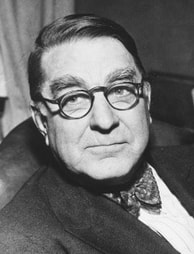
So, where did the souvenir helmet originate? If one should go looking for the answer to this question then the logical choice would be to first start with the real batting helmets. The very first batting helmets originated in the 1950's. Branch Rickey, who owned the American Baseball Cap Company, pushed for the design of a protective helmet that could meet the needs of ball players. Once that was established, then the first helmets came into regular use in Major League Baseball. The first team to wear helmets was the Pittsburgh Pirates in 1952, and of course this was a team that Branch Rickey had previously been in charge. It took awhile for the players to adjust to the helmets because it was something new and they seemed awkward to wear on the diamond. It wasn't until 1971 that MLB made it mandatory for all new players to wear helmets, but of course, some older players were allowed through a grandfather clause to not have to wear helmets. Just like everything else that can be marketed in a sport, someone came up with the idea to market souvenir batting helmets.

(Please keep in mind that I am still researching this information and the earliest info that deals with Bobbie Enterprises and Sports Product Corp. is made by logical assumptions by myself after looking inside my earliest helmets, determining the first year of logos and clubs, and then drawing conclusions.) As for who came up with the idea of souvenir helmets, I'm not for sure. I do know, however, that the first company that I can find note of that made helmets was a company called Bobbie Enterprises Inc. Bobbie Enterprises Inc. was based out of Buffalo, New York, and was a distributor of souvenir items in the 1960's and possibly 1950's? By looking at my Kansas City Athletics helmet, I assumed that 1963 may have been the earliest that these helmets were made because that was the first year they used the kelly green color, but after searching the insides of my helmets and referencing dates with Marc Okkonen's book, Baseball Uniforms of the 20th Century, I now believe that date may be earlier. I have dated the logo on one of my Cleveland Indians helmets back to the years of 1954-57 (see helmet below left). Inside it is stamped Bobbie Enterprises, N.Y., so could one of those years be the earliest on record for souvenir helmets? If so, it would make more sense considering how I pointed out earlier that the Pirates team started to wear them in '52. The strange thing, however, is that I keep running across baseball cards with Cleveland players wearing this type of cap in the mid-60's.
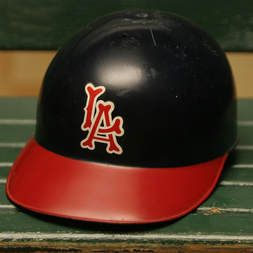
If you take the time to look at the paper that I found in a helmet still inside a bag, you would see that there is a copyright date of 1961 and the bottom of the paper says Sports Product Corp. There is no mention of Bobbie Enterprises Inc., but what is strange is how would a kid be able to build a Kansas City Athletics helmet when there is no offering of a solid kelly green helmet? The only logical answer to that in 1961 would be that the kid would have slapped the sticker on either a navy or black helmet which would make sense for 1961, so I'm guessing there is one of those out there somewhere that still eludes me. It would also be pretty hard to make the Los Angeles Angels helmet considering there is no black helmet with a red bill. All of the other sticker/helmet combinations of that time would be possible to design. So, the question is if the 1961 copyright date is right and the Los Angeles Angels were brought into MLB in 1961, is this then the start date for souvenir helmets? Now, the only thing that would throw a huge wrinkle into my thinking here would be if the 1961 copyright date is for the bobble head dolls. I only say that because that could be the case after reading this website that contains hockey bobble heads.
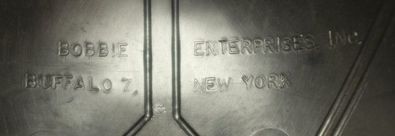
I recently found information on the web as to Laich Industries that stated that Walter Laich opened his plastics company in 1965. The main facility was based out of Cleveland, Ohio, and ran until its closure due to bankruptcy in 2005. The Sports Products Corp. was a sub group of the larger Laich Industries and it made sports souvenirs. Other parts of the company dealt with making items ranging anywhere from furniture to kitchen products. That information there really throws things into a loop as I go back to my Kansas City Athletics helmet. Inside of it is stamped Bobbie Enterprises, so were there two companies out there at the same time making souvenir batting helmets? Did Sports Products make helmets at the same time as Bobbie Enterprises and was Sports Products a part of Laich Industries at the time? The jury is still out on that one as I look for more information regarding both of these companies.
Awhile back, I was contacted by a man named Peter Boyko. He had filled me in on information regarding the Adjustrap and souvenir helmets in general. This is what he wrote:
The original promotional helmet was made of styrene with foam strips. In 1968 I designed an adjustable strap to replace the foam strips and changed the material from styrene to polypropylene. [I did] all [of] this while working under an understanding I would be able to acquire equal interest in sports products. When the deal didn't materialize I competed with Sports products as the Seventy Corp also out of Cleveland. This competition forced Sports Products to sell its company to Laich Plastic who at that time was a small plastic molder who was molding the helmets. The original owner of Sports Products was George Dickstein, a concessionaire at the Cleveland Indians' Stadium. I also promoted the first helmet day and from there came all of the wonderful baseball promotional events.
Peter Boyko
I by no means am saying that this is the cold hard truth, but this is what I have at the present time. Others have come forward disputing this claim in recent years, but it is what it is at the moment. You can find more of Peter Boyko's current day products by clicking here.
The original promotional helmet was made of styrene with foam strips. In 1968 I designed an adjustable strap to replace the foam strips and changed the material from styrene to polypropylene. [I did] all [of] this while working under an understanding I would be able to acquire equal interest in sports products. When the deal didn't materialize I competed with Sports products as the Seventy Corp also out of Cleveland. This competition forced Sports Products to sell its company to Laich Plastic who at that time was a small plastic molder who was molding the helmets. The original owner of Sports Products was George Dickstein, a concessionaire at the Cleveland Indians' Stadium. I also promoted the first helmet day and from there came all of the wonderful baseball promotional events.
Peter Boyko
I by no means am saying that this is the cold hard truth, but this is what I have at the present time. Others have come forward disputing this claim in recent years, but it is what it is at the moment. You can find more of Peter Boyko's current day products by clicking here.
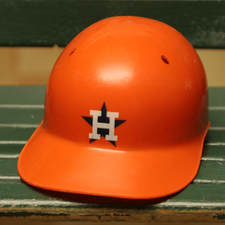
It should also be noted that somewhere in the middle of the Laich/Sports Product Corp. run that there were other helmets that appeared on the market with a marking stamped U.S. Cap Company. Now, I don't know if this is a separate company from Laich because the address is in Cleveland for this company. You can find these helmets on my website listed as "duck-billed" on various team pages (see helmet at left).
A change came after Laich shutdown and a new helmet maker emerged named Fotoball. Fotoball was not actually new to the field of marketing souvenirs because the company was actually founded in 1986. After the collapse of Laich, Fotoball acquired the rights to take over marketing of souvenir helmets for MLB teams.
Fotoball, however, had a very short-lived life when it came to the souvenir batting helmet as compared to Laich because K2 came along and bought out Fotoball in early 2004. K2 then made a separate group named K2 Licensed Products which was the premier sports giant when it came to souvenirs for any sport. K2 also owned Rawlings (and you will see Rawlings packaging and the company name stamped inside helmets) which it purchased in a stock swap in 2002. Besides Rawlings, K2 also controled 35 different other brand names that it marketed sports products through.
A change came after Laich shutdown and a new helmet maker emerged named Fotoball. Fotoball was not actually new to the field of marketing souvenirs because the company was actually founded in 1986. After the collapse of Laich, Fotoball acquired the rights to take over marketing of souvenir helmets for MLB teams.
Fotoball, however, had a very short-lived life when it came to the souvenir batting helmet as compared to Laich because K2 came along and bought out Fotoball in early 2004. K2 then made a separate group named K2 Licensed Products which was the premier sports giant when it came to souvenirs for any sport. K2 also owned Rawlings (and you will see Rawlings packaging and the company name stamped inside helmets) which it purchased in a stock swap in 2002. Besides Rawlings, K2 also controled 35 different other brand names that it marketed sports products through.
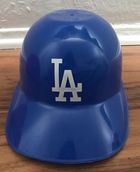
As of recently, however, a company called JSL has taken over the helmet business. On their website they state that they are formerly K2 and Fotoball and that they deliver products through Rawlings which would explain the nice helmets that still exist. Rawlings helmets can be pruchsed through GT Wholesale, but I have no idea who they are affilated with at this time. From the looks of things, however, JSL is into a ton of different promotional items. I have no idea where they make or get their products from, but many promotional helmets in recent years that I have collected are currently manufactured overseas in China and nine times out of ten there is no company listed inside the helmet. Some of the helmets are well made, while others are pieces of junk.
It should be noted that recently teams sell helmets (as seen left) that are filled with nachos and cheese among other things. These helmets do not have any type of Adjustrap inside of them, however, they are made to fit on a person's head. Personally, I have no interest in collecting those helmets because they were mainly intended to make money by selling food in them. I want only the helmets whose sole intention was to be placed on a child's head so that he or she could recreate their favorite baseball moments from their favorite baseball player. As for the future of how long this industry will last or where it will go from here, only time will tell.
It should be noted that recently teams sell helmets (as seen left) that are filled with nachos and cheese among other things. These helmets do not have any type of Adjustrap inside of them, however, they are made to fit on a person's head. Personally, I have no interest in collecting those helmets because they were mainly intended to make money by selling food in them. I want only the helmets whose sole intention was to be placed on a child's head so that he or she could recreate their favorite baseball moments from their favorite baseball player. As for the future of how long this industry will last or where it will go from here, only time will tell.